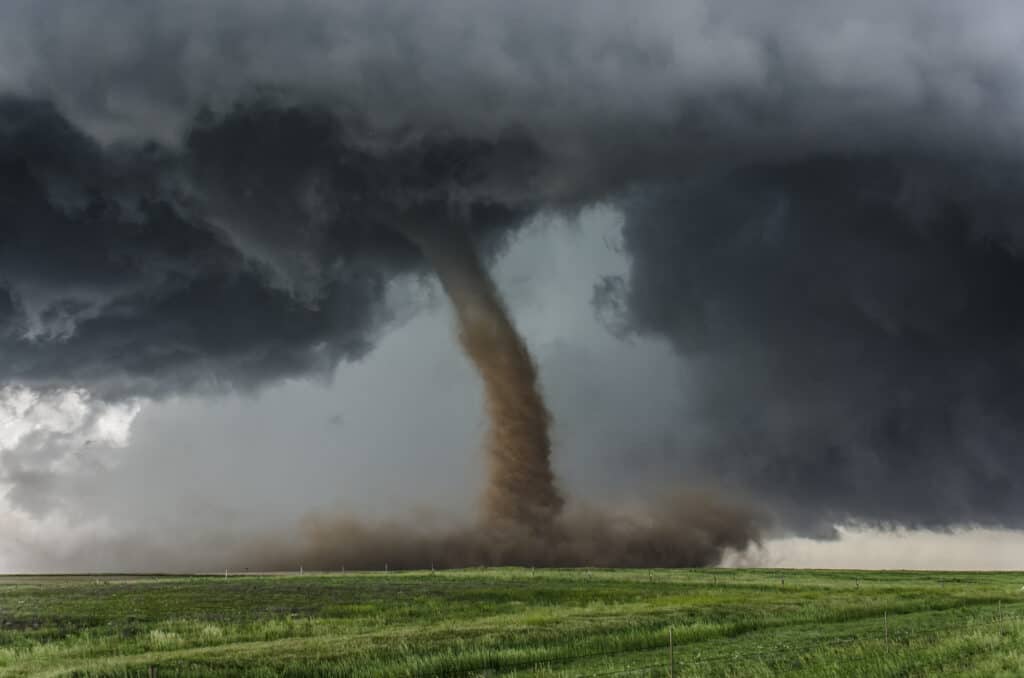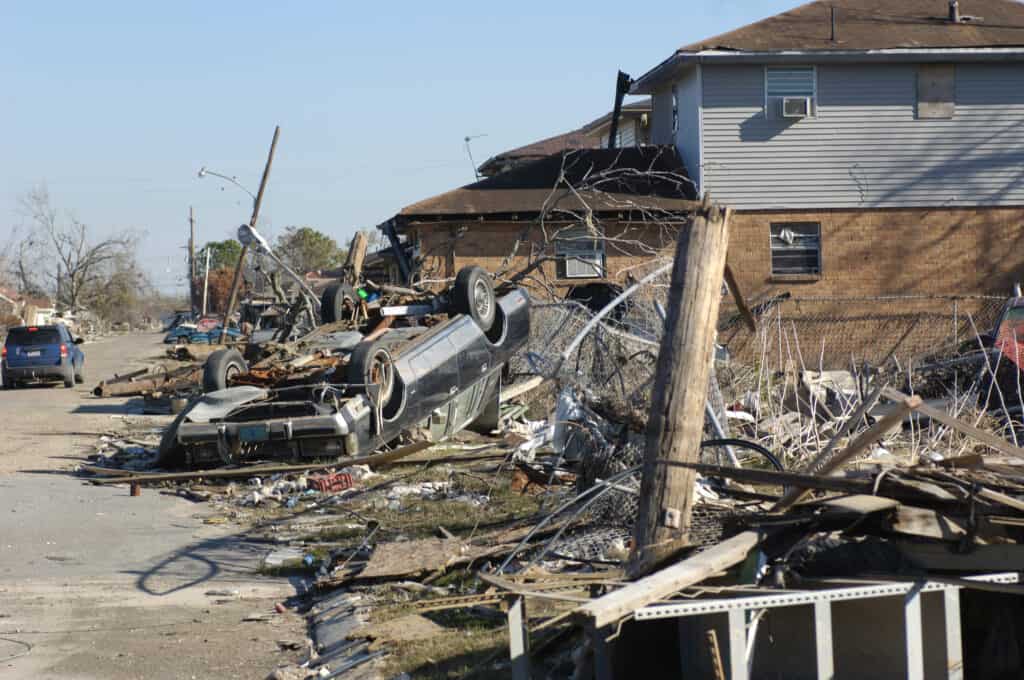An area of low pressure developed over the southeastern Bahamas on August 23, and by August 24 it had developed into Tropical Storm Katrina. On the evening of August 25th, a Category 1 hurricane with westward-bound 80-mph winds came ashore in southeast Florida. After moving across south Florida and into the tropical Gulf of Mexico on August 28, Katrina rapidly strengthened into a Category 5 hurricane. Southeast Louisiana was the first to feel Katrina’s 125 mph winds, and then the northern Gulf Coast all along Mississippi Gulf Coast, with sustained winds of 120mph.
Katrina made landfall in southern Mississippi on the afternoon of August 29 and wreaked unimaginable havoc along its course. The death toll and property loss in New Orleans were exacerbated by the failure of the levees that protect the city from Lake Pontchartrain. By the evening of August 31, at least 80% of New Orleans had been submerged by floodwaters. There were many variables that contributed to the mass destruction left behind by Hurricane Katrina, which we will break down in detail below.
Rainfall

The severe flooding of Hurricane Katrina caused widespread death and destruction.
©Tad Denson/Shutterstock.com
Most rainfall was near the coast and east of Katrina’s eye, according to radar. Average rainfall was 5 to 10 inches, sometimes reaching 12 inches. Rain bands east of Katrina’s eye dumped 3-6 inches of rain on northwest Florida. Philpot, FL recorded 7.80 inches of rain in 48 hours, the most in our county warning zone. Katrina’s landfall brought torrential rain and flash floods.
Most deaths were caused by flooding, which was triggered by engineering flaws in New Orleans’ levees. 80% of the city and many adjacent parishes were underwater for weeks. The floods destroyed most of New Orleans’ transportation and communication systems, leaving tens of thousands of citizens without food, shelter, or other basics.
In the weeks after the New Orleans tragedy, federal, local, and private rescue missions evacuated displaced individuals out of the city. Numerous investigations found that the U.S. The Army Corps of Engineers developed and built the region’s levees decades earlier, but federal courts ruled that the Corps could not be held financially accountable due to sovereign immunity in the 1928 Flood Control Act.
Tornadoes

Tornadoes in Katrina’s outer bands were numerous but often quite brief.
©Minerva Studio/Shutterstock.com
Numerous tornadoes formed on August 28 and 29 because of Hurricane Katrina’s outer bands, particularly in southern Alabama and northwest Florida panhandle areas. Five F0 tornadoes struck the northwest Florida panhandle, and four struck southern Alabama.
Tornadoes in these Katrina bands were often quite brief, touching down for no more than two miles at most. The longest reported tornado path was three miles long, and it was in Santa Rosa County, Florida, not far from the town of Munson. Tornadoes with path lengths of F1 and F2 touched inland in the Jackson, Mississippi, and Birmingham, Alabama, areas. Trees and power lines were the primary targets of these weak outer band tornadoes. We are fortunate that no lives were lost or injured during these tornadoes.
Wind Speed
The Grand Isle, Louisiana, area is estimated to have seen winds of up to 140 mph from Hurricane Katrina. The NWS Doppler Radar detected winds of up to 132 mph between 3,000 and 4,000 feet above ground level as Katrina moved farther north and made a second strike at the Mississippi/Louisiana line in the morning. It is estimated that between eighty and ninety percent (or about 104 and 119 mph) of the maximum wind speed value made it to the ground.
Tree damage in Stone and George Counties in south Mississippi was comparable to that in Atmore and Brewton in south central Alabama in 2004. This velocity loop (759-859am CDT) shows that the storm’s eye is located to the southwest of the area with the strongest surface winds.
How Much Damage Did It Cause?

In 2005, Hurricane Katrina devastated much of New Orleans. The city’s Ninth Ward was hit particularly hard.
©Marc Pagani Photography/Shutterstock.com
Category 5 Hurricane Katrina struck in late August 2005 and caused $125 billion in damage, especially in New Orleans and the surrounding areas. It’s tied with Hurricane Harvey as the costliest tropical cyclone ever. Hurricane Katrina was large and powerful, causing much destruction and sadly, many deaths (833 individuals). It was costlier than Hurricane Andrew in 1992. Katrina was one of the five worst U.S. hurricanes of all time. It was the fourth-most intense Atlantic hurricane to hit the contiguous U.S.
Extreme damage was recorded in Alabama and the western part of Florida’s panhandle, and the number of fatalities inflicted by this hurricane was shocking. There was widespread coverage of the New Orleans area because of the storm’s impact on the city. The devastating impacts of Hurricane Katrina make it one of the most terrifying natural catastrophes in U.S. history.
Could a Storm Like Katrina Happen Again?
You probably didn’t know this, but the last time a hurricane of category 3 or higher made landfall in the United States was in 2005. A “major” storm is defined as a hurricane with sustained winds of 111 miles per hour or more, making it category 3 and above. Of course, high rainfall and tidal waves along the coast also caused damage from storms that were not Category 3 like Hurricane Sandy.
Our coastlines have been hit by multiple storms in years such as 1964, 2004, and 2005. And we can see that years without major storms are not uncommon. A recent NASA study used a model to predict hurricane activity. Based on their research, they found that every year there is a 40% chance that a category 3 storm will make landfall. According to the numbers, a nine-year lapse occurs once every 177 years. However, that fact does not make a catastrophic storm more likely. Scientists haven’t pinpointed a single, recurrent factor that accounts for this phenomenon, so it may just be a matter of chance.
Sources:
The photo featured at the top of this post is © LiL SUS/Shutterstock.com
Sources
- Here, Available here: https://www.here.com/company/blog/disaster-response-management
- History, Available here: https://www.history.com/topics/natural-disasters-and-environment/hurricane-katrina
- Brittanica, Available here: https://www.britannica.com/event/Hurricane-Katrina
Thank you for reading! Have some feedback for us? Contact the AZ Animals editorial team.






